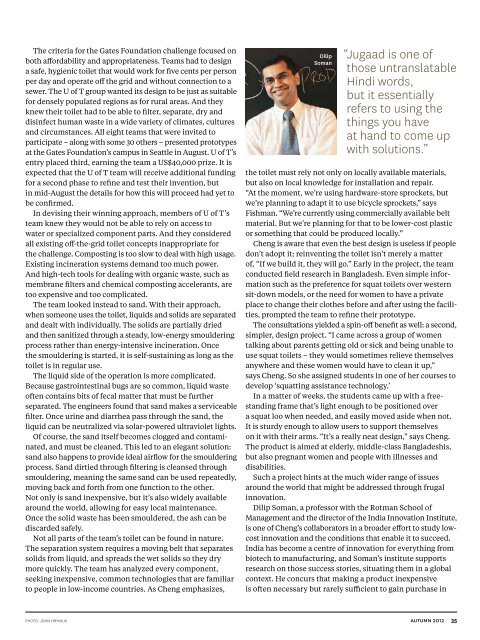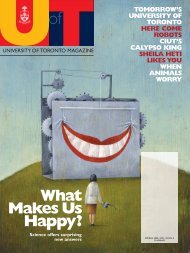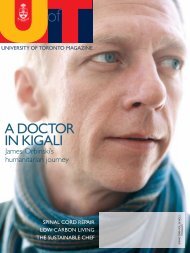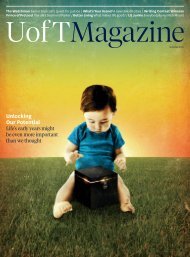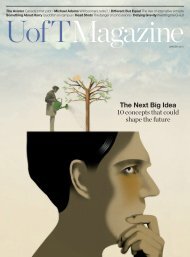8 MB - University of Toronto Magazine
8 MB - University of Toronto Magazine
8 MB - University of Toronto Magazine
- No tags were found...
Create successful ePaper yourself
Turn your PDF publications into a flip-book with our unique Google optimized e-Paper software.
The criteria for the Gates Foundation challenge focused on<br />
both affordability and appropriateness. Teams had to design<br />
a safe, hygienic toilet that would work for five cents per person<br />
per day and operate <strong>of</strong>f the grid and without connection to a<br />
sewer. The U <strong>of</strong> T group wanted its design to be just as suitable<br />
for densely populated regions as for rural areas. And they<br />
knew their toilet had to be able to filter, separate, dry and<br />
disinfect human waste in a wide variety <strong>of</strong> climates, cultures<br />
and circumstances. All eight teams that were invited to<br />
participate – along with some 30 others – presented prototypes<br />
at the Gates Foundation’s campus in Seattle in August. U <strong>of</strong> T’s<br />
entry placed third, earning the team a US$40,000 prize. It is<br />
expected that the U <strong>of</strong> T team will receive additional funding<br />
for a second phase to refine and test their invention, but<br />
in mid-August the details for how this will proceed had yet to<br />
be confirmed.<br />
In devising their winning approach, members <strong>of</strong> U <strong>of</strong> T’s<br />
team knew they would not be able to rely on access to<br />
water or specialized component parts. And they considered<br />
all existing <strong>of</strong>f-the-grid toilet concepts inappropriate for<br />
the challenge. Composting is too slow to deal with high usage.<br />
Existing incineration systems demand too much power.<br />
And high-tech tools for dealing with organic waste, such as<br />
membrane filters and chemical composting accelerants, are<br />
too expensive and too complicated.<br />
The team looked instead to sand. With their approach,<br />
when someone uses the toilet, liquids and solids are separated<br />
and dealt with individually. The solids are partially dried<br />
and then sanitized through a steady, low-energy smouldering<br />
process rather than energy-intensive incineration. Once<br />
the smouldering is started, it is self-sustaining as long as the<br />
toilet is in regular use.<br />
The liquid side <strong>of</strong> the operation is more complicated.<br />
Because gastrointestinal bugs are so common, liquid waste<br />
<strong>of</strong>ten contains bits <strong>of</strong> fecal matter that must be further<br />
separated. The engineers found that sand makes a serviceable<br />
filter. Once urine and diarrhea pass through the sand, the<br />
liquid can be neutralized via solar-powered ultraviolet lights.<br />
Of course, the sand itself becomes clogged and contaminated,<br />
and must be cleaned. This led to an elegant solution:<br />
sand also happens to provide ideal airflow for the smouldering<br />
process. Sand dirtied through filtering is cleansed through<br />
smouldering, meaning the same sand can be used repeatedly,<br />
moving back and forth from one function to the other.<br />
Not only is sand inexpensive, but it’s also widely available<br />
around the world, allowing for easy local maintenance.<br />
Once the solid waste has been smouldered, the ash can be<br />
discarded safely.<br />
Not all parts <strong>of</strong> the team’s toilet can be found in nature.<br />
The separation system requires a moving belt that separates<br />
solids from liquid, and spreads the wet solids so they dry<br />
more quickly. The team has analyzed every component,<br />
seeking inexpensive, common technologies that are familiar<br />
to people in low-income countries. As Cheng emphasizes,<br />
Dilip<br />
Soman<br />
“Jugaad is one <strong>of</strong><br />
those untranslatable<br />
Hindi words,<br />
but it essentially<br />
refers to using the<br />
things you have<br />
at hand to come up<br />
with solutions.”<br />
the toilet must rely not only on locally available materials,<br />
but also on local knowledge for installation and repair.<br />
“At the moment, we’re using hardware-store sprockets, but<br />
we’re planning to adapt it to use bicycle sprockets,” says<br />
Fishman. “We’re currently using commercially available belt<br />
material. But we’re planning for that to be lower-cost plastic<br />
or something that could be produced locally.”<br />
Cheng is aware that even the best design is useless if people<br />
don’t adopt it; reinventing the toilet isn’t merely a matter<br />
<strong>of</strong>, “If we build it, they will go.” Early in the project, the team<br />
conducted field research in Bangladesh. Even simple information<br />
such as the preference for squat toilets over western<br />
sit-down models, or the need for women to have a private<br />
place to change their clothes before and after using the facilities,<br />
prompted the team to refine their prototype.<br />
The consultations yielded a spin-<strong>of</strong>f benefit as well: a second,<br />
simpler, design project. “I came across a group <strong>of</strong> women<br />
talking about parents getting old or sick and being unable to<br />
use squat toilets – they would sometimes relieve themselves<br />
anywhere and these women would have to clean it up,”<br />
says Cheng. So she assigned students in one <strong>of</strong> her courses to<br />
develop ‘squatting assistance technology.’<br />
In a matter <strong>of</strong> weeks, the students came up with a freestanding<br />
frame that’s light enough to be positioned over<br />
a squat loo when needed, and easily moved aside when not.<br />
It is sturdy enough to allow users to support themselves<br />
on it with their arms. “It’s a really neat design,” says Cheng.<br />
The product is aimed at elderly, middle-class Bangladeshis,<br />
but also pregnant women and people with illnesses and<br />
disabilities.<br />
Such a project hints at the much wider range <strong>of</strong> issues<br />
around the world that might be addressed through frugal<br />
innovation.<br />
Dilip Soman, a pr<strong>of</strong>essor with the Rotman School <strong>of</strong><br />
Management and the director <strong>of</strong> the India Innovation Institute,<br />
is one <strong>of</strong> Cheng’s collaborators in a broader effort to study lowcost<br />
innovation and the conditions that enable it to succeed.<br />
India has become a centre <strong>of</strong> innovation for everything from<br />
biotech to manufacturing, and Soman’s institute supports<br />
research on those success stories, situating them in a global<br />
context. He concurs that making a product inexpensive<br />
is <strong>of</strong>ten necessary but rarely sufficient to gain purchase in<br />
photo: John Hryniuk<br />
Autumn 2012 35


